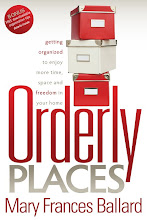Fall is officially here. In some parts of our country the weather may not show it, but it is time to get moving towards the season filled with decorating and entertaining. This month we will concentrate on getting the kitchen organized and ready for holiday cooking and serving.
- Inventory your linens and purge what you haven’t used in years. If some hold sentimental value, see if someone in your family can use them and give them the honor they deserve. If some are in need of repair, make the decision to take care of that or to move them on. Removing those that you do not use will make more space for those that you love and use.
- Look over your dinnerware and remove pieces that cannot be used because of chips or other damage. If there are odd pieces that cannot be used with other items, move them on, too. Complete sets that are stored in boxes and never opened should be sold, donated or given to someone who wants them. As with your linens, move on pieces that are simply taking up space.
- If you send holiday cards and are very selective in what you prefer, purchase them now while the selection is good. You can find good sales on them later on, but the selection will not be as favorable.
- Inventory your spices, extracts and specialty kitchen gadgets before the holiday rush. Remove those that have expired or no longer useful and make a list of what you will need for holiday cooking. Be careful not to purchase items that you will not have room to store the rest of the year.
- Inventory your cookbooks and recipe collection. Purge those that are no longer useful. Remember recipes for anything you need can be found online.
- Inventory the pantry making note of items you will need for special recipes you use during the holidays. Look for specials on these items in the local grocery stores.
- Continue sorting summer clothing and other hot weather items. Donate or sell those you no longer want or need.
- Begin the purge of toys that children have outgrown so there is room for new items that arrive during the holidays.
- Clean the windows, inside and out. Most of the summer grasses have shed their pollen, the weather is good for outdoor work and the busyness of November and December will make the task more inconvenient. For a review of Windex Outdoor, check out the posting for August 17, 2010 on my special tips blog. http://www.blogger.com/post-edit.g?blogID=7640181261458137999&postID=3051892184347792985
The end of the month also brings Halloween and the Trick or Treat invaders.
- First you want to be sure the pathway to your door is safe. Remember to clean the driveway, sidewalk, steps and porch while it is still daylight. Fallen leaves can be slippery especially when wet so they should be removed as well as any toys, twigs, etc. Make sure this area is well lit by leaving your porch light and any other light fixtures on during the Trick or Treat hours. Those hours are set by each locality.
It is recommended that you give only individually pre-wrapped candy and keep it in a convenient basket, bowl or other container that is easy for you to manage at the door. You should not allow each child to reach into your container to get the candy since each one could be contaminating the other pieces with his hands. Rather, you should choose and drop the candy into each child's bag yourself. Keep hand sanitizer near the door and use it yourself as often as you think necessary.
As an extra precaution, you may want to use disinfecting wipes to clean your doorbell or door handles if you keep it closed between visitors. This can be done periodically during the evening or at the end when Trick or Treating is over. It is a shame we need to be so careful, but it is always better to be safe than sorry and we want to do our part in keeping our homes and neighbors as healthy and safe as possible.

